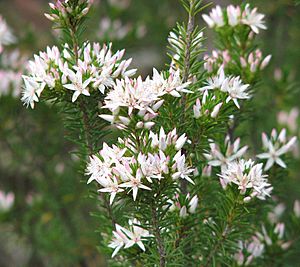Starflowers facts for kids
Quick facts for kids Starflowers |
|
|---|---|
 |
|
| Calytrix tetragona | |
| Scientific classification |
|
| Kingdom: | Plantae |
| Clade: | Tracheophytes |
| Clade: | Angiosperms |
| Clade: | Eudicots |
| Clade: | Rosids |
| Order: | Myrtales |
| Family: | Myrtaceae |
| Subfamily: | Myrtoideae |
| Tribe: | Chamelaucieae |
| Genus: | Calytrix Labill. |
| Synonyms | |
|
|
Calytrix is a group of beautiful shrubs. These plants are often called starflowers because their blooms look like tiny stars. They belong to the Myrtaceae family, which also includes eucalyptus trees.
Starflowers were first officially described as a group in 1806. They are found only in Australia. You can find them growing in the Northern Territory, Queensland, South Australia, and Western Australia.
What are Starflowers?
Starflowers are shrubs, which means they are woody plants smaller than trees. They usually have many branches. Their flowers are often brightly colored. They can be yellow, pink, purple, or white.
The flowers have a special shape. They have five petals that spread out like a star. This is how they got their common name, starflowers.
Where Starflowers Grow
All kinds of Calytrix plants are endemic to Australia. This means they naturally grow nowhere else in the world. They are an important part of Australia's unique plant life.
You can find them in many different parts of Australia. They grow in various habitats. These include sandy plains, rocky areas, and open woodlands.
Different Kinds of Starflowers
There are many different types, or species, of starflowers. Each species has its own unique features. Some are small and low-growing. Others can be taller shrubs.
Here are a few examples of starflower species:
- Calytrix angulata - This one has bright yellow flowers.
- Calytrix asperula - Known for its brush-like appearance.
- Calytrix fraseri - This species often has lovely pink flowers.
- Calytrix tetragona - Also called the common fringe-myrtle.
Each species of starflower adds to the beauty of the Australian landscape. They are a wonderful example of Australia's amazing plant diversity.
See also
 In Spanish: Calytrix para niños
In Spanish: Calytrix para niños

